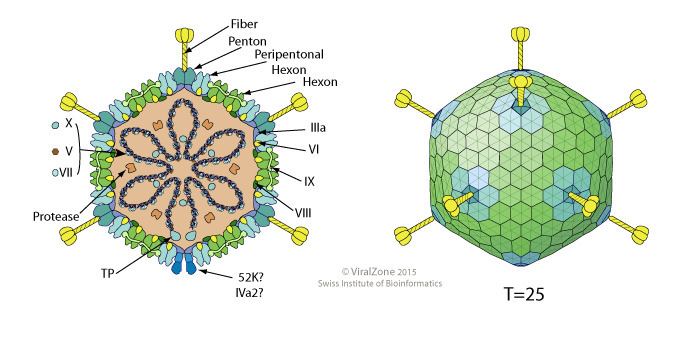Group Group I (dsDNA) Rank Genus | ||
 | ||
Similar Avian adenovirus, Bovine adenovirus, Varicellovirus, Lymphocryptovirus, Orthopoxvirus | ||
Medical vocabulary what does mastadenovirus mean
Mastadenovirus is a genus of viruses, in the family Adenoviridae. Human, mammals, and vertebrates serve as natural hosts. There are currently 25 species in this genus, including the type species Human mastadenovirus C. Diseases associated with this genus include: very common human infection, estimated to be responsible for between 2% and 5% of all respiratory infections. usually mild respiratory, gastrointestinal and eye infections. serotypes 3, 5 and 7: lower respiratory tract infections. serotypes 8, 19, and 37: epidemic keratoconjunctivitis. serotypes 4 and 7: acute respiratory disease. serotypes 40 and 41: gastroenteritis. serotype 14: can cause potentially fatal adenovirus infections. Canine adenovirus 1 (CAdV-1) can lead to death in puppies, or encephalitis in other carnivore species.
Contents
Taxonomy
Group: dsDNA
Structure
Viruses in Mastadenovirus are non-enveloped, with icosahedral geometries, and T=25 symmetry. The diameter is around 90 nm. Genomes are linear and non-segmented, around 35-36kb in length. The genome codes for 40 proteins.
Life Cycle
Viral replication is nuclear. Entry into the host cell is achieved by attachment of the viral fibers to the host CAR adhesion receptor. Subsequent binding of the penton protein to host integrin entry receptors mediates internalization into the host cell by clathrin-mediated endocytosis of the virus and fiber shedding. Some serotypes also seem to use macropinocytosis. Disruption of host endosomal membrane by lytic protein VI releases the viral capsid in the cytosol. Microtubular transport toward nucleus of the viral genome still protected by the core protein VII and a partial capsid mainly composed of hexons and protein IX. Docking at the NPC and capsid disruption. Import of the viral genome into host nucleus mediated by core protein VII. Transcription of early genes (E genes) by host RNA pol II: these proteins optimize the cellular milieu for viral replication, and counteract a variety of antiviral defenses. Intermediate genes activate replication of the DNA genome by DNA strand displacement in the nucleus. Expression of L4-22K and L4-33K causes early to late switch. Transcription of late genes (L genes) by host RNA pol II, mostly encoding structural proteins. Host translation shutoff performed by the viral 100K protein. Assembly of new virions in the nucleus. Virions are released by lysis of the cell. Virion maturation by the viral proteasehost receptors, which mediates clathrin-mediated endocytosis. Replication follows the DNA strand displacement model. Dna templated transcription, with some alternative splicing mechanism is the method of transcription. Translation takes place by ribosomal shunting. The virus exits the host cell by nuclear envelope breakdown, viroporins, and lysis. Human, mammals, and vertebrates serve as the natural host. Transmission routes are fecal-oral and respiratory.
